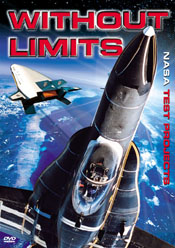| Release List | Reviews | Price Search | Shop | Newsletter | Forum | DVD Giveaways | Blu-Ray/ HD DVD | Advertise |
| Reviews & Columns |
|
Reviews DVD TV on DVD Blu-ray International DVDs Theatrical Reviews by Studio Video Games Features Collector Series DVDs Easter Egg Database Interviews DVD Talk TV DVD Talk Radio Feature Articles Columns Anime Talk DVD Savant HD Talk Horror DVDs Silent DVD
|
DVD Talk Forum |
|
|
| Resources |
|
DVD Price Search Customer Service #'s RCE Info Links |
|
Columns
|
 |
Savant Short Review:WITHOUT LIMITS: NASA Test Projects
|
||||
NASA trots out its best research projects across the past 40 years, showing us in three docus how a number of experimental flight and space projects grew out of one another, and presenting in detail a number of concepts and theories used in cutting-edge aeronautics.
Using interviews with NASA spokesmen, engineers, and test pilots, the genesis and development of a number of little-publicized space-related flight vehicles and technologies is chronicled in these three lengthy documentaries. There's a lot to be learned here, and there's a lot of good footage, all of it free of TV-doc hype. "If that retro rocket fires one second too late, he'll be burned alive!", I remember one ratings-hungry show repeating several times. Here we get good facts about the projects, see real-deal, on-the-spot vintage footage, and are given good arguments in favor of the pure research that made them possible. The actual main title on the shows reads: Test Flights: Beyond the Limits. The people-connection is stressed, and not just in the risks taken by test pilots. They talk more like engineers (which many of them are) and one husband-wife team take turns flying the planes and manning the telemetry on the ground. There's one obvious NASA spokesman who keeps showing up to smooth rough edges and make sure the agency is shown in the best light, but he's one of the directors of the test facility, and seems very sincere. Two of the test pilots briefly interviewed are the real Chuck Yeager and Scott Crossfield, who were immortalized in The Right Stuff. There's a do-it-yourself flavor to some of the proceedings, as when the engineers worked unofficial weekends to put together a prototype lifting body re-entry craft. Made of wood, it proved that the idea of an airplane without wings works, and got the futuristic ships onto the test schedule. Another scientist was obsessed with a harrowing Sioux City airliner crash, where the pilot brilliantly guided a plane with no working control surfaces, solely by manipulating the engines. Modeling with computers, simulators, and finally using real test planes, they developed a prototype on-board computer that may someday be used on airliners, giving pilots a chance to land if they lose normal hydraulic control. There's a nice through-line of research going back to the original X-1 and X-15 tests to show the origins of ideas, and how research used in one program sometimes finds expression in another. A computer system in a test airplane, for instance, was installed directly into the Space Shuttle when it was determined that it fit the bill. The shows are more than a little repetititve at times, and issues aren't always tightly organized. This won't mean a fig to those interested in the topic, who should be very pleased. The production appears to have come at least partially from 'inside' NASA, and the authoritative point of view is a big plus. Image's DVD of Without Limits: Nasa Test Projects is a good to very good disc, technically. The old video and film are nicely transferred. The graphics and effects are unstylish but efficient. The extras (beyond the three very weighty docus) turn out to be seven aerospace short subjects promoting and explaining new programs, like the X-33 engine, and a commercial space plane called Venturestar. A couple of the promos are rather low-res. There's also a still gallery, and a DVD-rom feature with 'a variety of fun and educational resource tools' from NASA - glider kits, biographies, poster art, and aeronautic facts.
On a scale of Excellent, Good, Fair, and Poor,
Review Staff | About DVD Talk | Newsletter Subscribe | Join DVD Talk Forum |
|
| Release List | Reviews | Price Search | Shop | SUBSCRIBE | Forum | DVD Giveaways | Blu-Ray/ HD DVD | Advertise |






